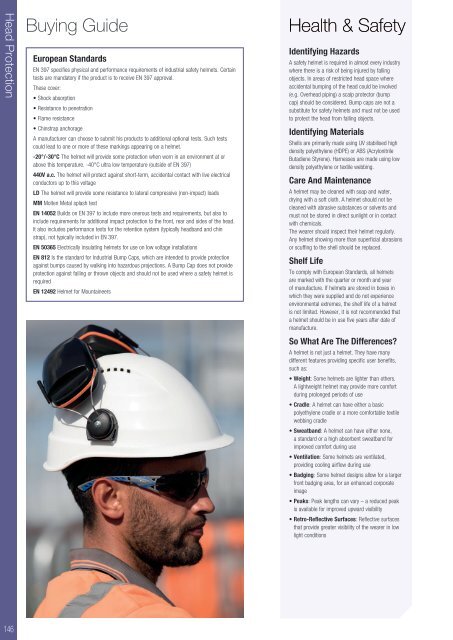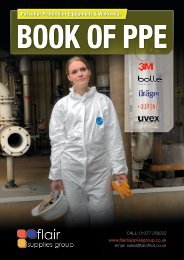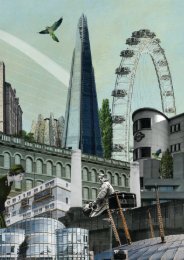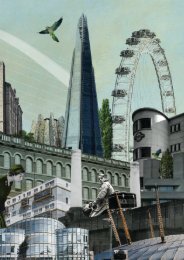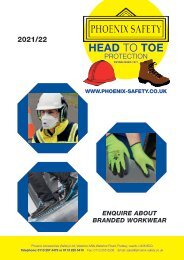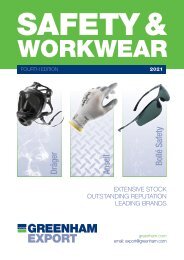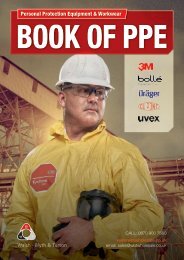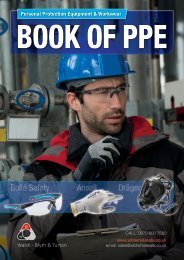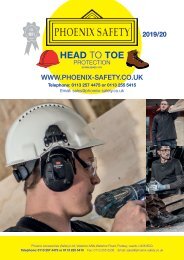Phoenix Safety Head to Toe Protection Catalogue 2021
Phoenix Safety Head to Toe Protection Catalogue 2021
Phoenix Safety Head to Toe Protection Catalogue 2021
Create successful ePaper yourself
Turn your PDF publications into a flip-book with our unique Google optimized e-Paper software.
<strong>Head</strong> <strong>Protection</strong><br />
Buying Guide<br />
European Standards<br />
EN 397 specifies physical and performance requirements of industrial safety helmets. Certain<br />
tests are manda<strong>to</strong>ry if the product is <strong>to</strong> receive EN 397 approval.<br />
These cover:<br />
• Shock absorption<br />
• Resistance <strong>to</strong> penetration<br />
• Flame resistance<br />
• Chinstrap anchorage<br />
A manufacturer can choose <strong>to</strong> submit his products <strong>to</strong> additional optional tests. Such tests<br />
could lead <strong>to</strong> one or more of these markings appearing on a helmet.<br />
-20°/-30°C The helmet will provide some protection when worn in an environment at or<br />
above this temperature. -40°C ultra low temperature (outside of EN 397)<br />
440V a.c. The helmet will protect against short-term, accidental contact with live electrical<br />
conduc<strong>to</strong>rs up <strong>to</strong> this voltage<br />
LD The helmet will provide some resistance <strong>to</strong> lateral compressive (non-impact) loads<br />
MM Molten Metal splash test<br />
EN 14052 Builds on EN 397 <strong>to</strong> include more onerous tests and requirements, but also <strong>to</strong><br />
include requirements for additional impact protection <strong>to</strong> the front, rear and sides of the head.<br />
It also includes performance tests for the retention system (typically headband and chin<br />
strap), not typically included in EN 397.<br />
EN 50365 Electrically insulating helmets for use on low voltage installations<br />
EN 812 Is the standard for Industrial Bump Caps, which are intended <strong>to</strong> provide protection<br />
against bumps caused by walking in<strong>to</strong> hazardous projections. A Bump Cap does not provide<br />
protection against falling or thrown objects and should not be used where a safety helmet is<br />
required<br />
EN 12492 Helmet for Mountaineers<br />
Health & <strong>Safety</strong><br />
Identifying Hazards<br />
A safety helmet is required in almost every industry<br />
where there is a risk of being injured by falling<br />
objects. In areas of restricted head space where<br />
accidental bumping of the head could be involved<br />
(e.g. Overhead piping) a scalp protec<strong>to</strong>r (bump<br />
cap) should be considered. Bump caps are not a<br />
substitute for safety helmets and must not be used<br />
<strong>to</strong> protect the head from falling objects.<br />
Identifying Materials<br />
Shells are primarily made using UV stabilised high<br />
density polyethylene (HDPE) or ABS (Acrylonitrile<br />
Butadiene Styrene). Harnesses are made using low<br />
density polyethylene or textile webbing.<br />
Care And Maintenance<br />
A helmet may be cleaned with soap and water,<br />
drying with a soft cloth. A helmet should not be<br />
cleaned with abrasive substances or solvents and<br />
must not be s<strong>to</strong>red in direct sunlight or in contact<br />
with chemicals.<br />
The wearer should inspect their helmet regularly.<br />
Any helmet showing more than superficial abrasions<br />
or scuffing <strong>to</strong> the shell should be replaced.<br />
Shelf Life<br />
To comply with European Standards, all helmets<br />
are marked with the quarter or month and year<br />
of manufacture. If helmets are s<strong>to</strong>red in boxes in<br />
which they were supplied and do not experience<br />
environmental extremes, the shelf life of a helmet<br />
is not limited. However, it is not recommended that<br />
a helmet should be in use five years after date of<br />
manufacture.<br />
So What Are The Differences?<br />
A helmet is not just a helmet. They have many<br />
different features providing specific user benefits,<br />
such as:<br />
• Weight: Some helmets are lighter than others.<br />
A lightweight helmet may provide more comfort<br />
during prolonged periods of use<br />
• Cradle: A helmet can have either a basic<br />
polyethylene cradle or a more comfortable textile<br />
webbing cradle<br />
• Sweatband: A helmet can have either none,<br />
a standard or a high absorbent sweatband for<br />
improved comfort during use<br />
• Ventilation: Some helmets are ventilated,<br />
providing cooling airflow during use<br />
• Badging: Some helmet designs allow for a larger<br />
front badging area, for an enhanced corporate<br />
image<br />
• Peaks: Peak lengths can vary – a reduced peak<br />
is available for improved upward visibility<br />
• Retro-Reflective Surfaces: Reflective surfaces<br />
that provide greater visibility of the wearer in low<br />
light conditions<br />
146


